Yes, kids can rock climb! It is an excellent sport for all members of the family. Climbing gyms are designed for climbers of all ages and often have additional areas for kids to try it out. You can visit for a few hours as a family or enroll kids in classes. Here is everything you need to know about rock climbing for kids to ace a visit to the gym and start their climbing journey. If you’re anything like us, climbing might become a favorite family sport.
Important reminder: the climbing gym IS NOT a playground. Do not take your kids unless you’re willing to enforce all rules AND willing to leave if your kids cannot follow the rules. For kids looking to play, a climbing dome or backyard climber might be a better climbing option.
Types of Rock Climbing
Did you know that there are two types of climbing that your kids can do in the gym? It can be fun to try both kinds of climbing. Sometimes kids will have a preference for one over the other.
1. Bouldering
Bouldering is done on shorter walls without a rope. Large thick mats are placed under bouldering walls. This can be a super fun way for kids to try lots of moves and for the family to all climb together. The bouldering climbs are called problems and generally follow one color to the top or a marked finishing hold. If you touch only one color and get both hands on the finishing hold, the problem is completed. Of course, you can also climb using any colors and holds. It is important to note that in addition to climbing up, kids must also be able to climb down.
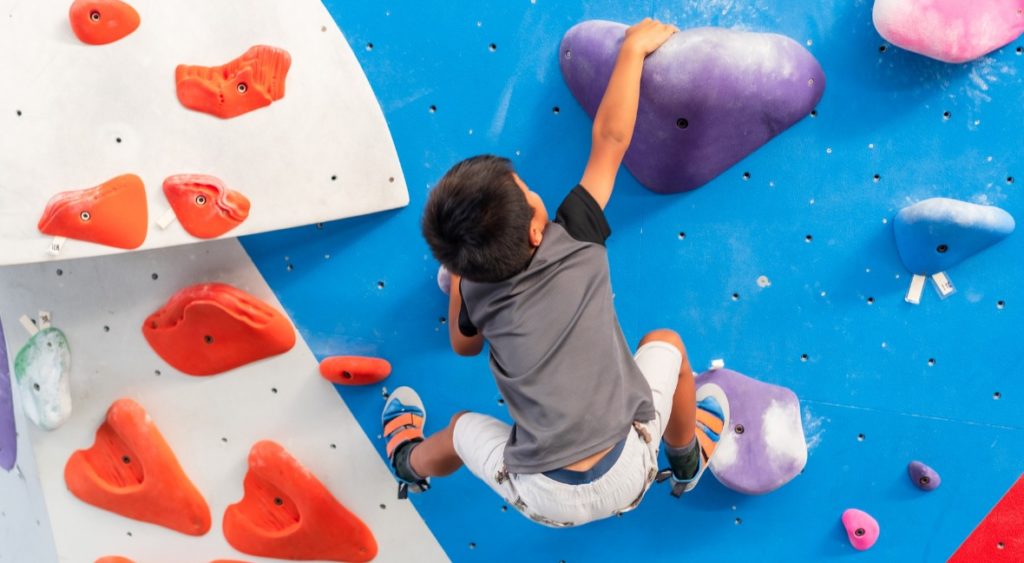
Even though they’re shorter, the most accessible bouldering problems tend to be more challenging than the most manageable rope climbs. Often a kid’s area will have lots of bouldering options.
2. Rope Climbing
Rope climbing is done on taller walls while tied into a rope. A harness acts as an attachment point for the rope. A belayer stands on the ground and uses a particular device attached to their harness to pull up the slack in the rope as kids climb. Kids are lowered down by the belayer when they have climbed as high as they would like.
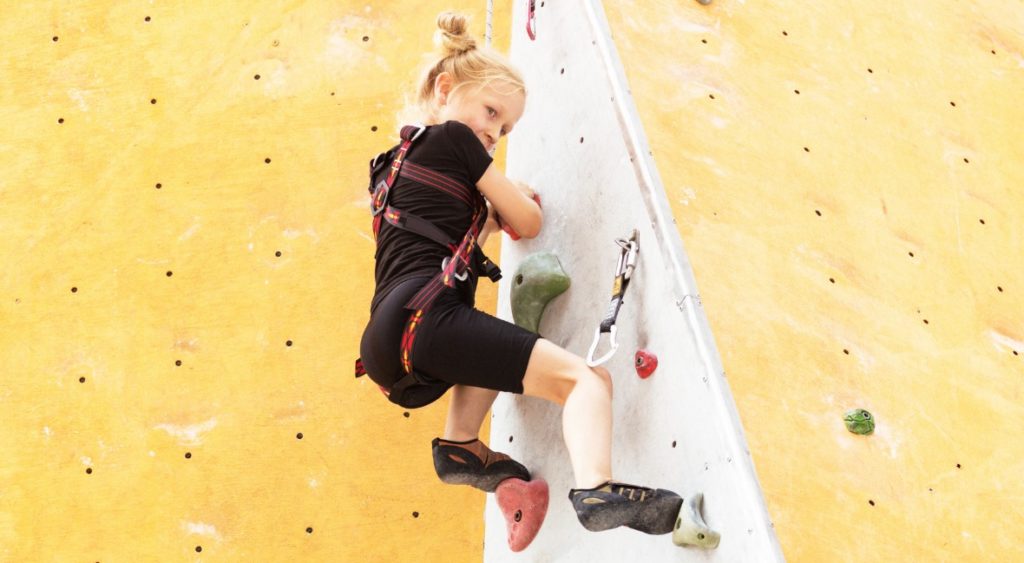
It is important to have kids practice being lowered down while still low to the ground. Kids can experience what it feels like to put their weight on the rope and let go of the wall. This can prevent kids from freaking out or clinging onto the wall when they’re 30 feet in the air.
If you would like to go climbing with your family often, it would be worth taking a belay class at your gym. You’ll then be able to belay for your family and won’t need to hire a staff member to do so for you.
Rock Climbing for Kids Safety
Kids can stay safe by learning how to fall correctly and following the rules.
• How to Fall Safely When Bouldering
Climbing gyms are filled with mats but falling incorrectly can still result in injury. Learning to fall is an important skill when bouldering.
When falling, think: feet, butt, back, land on your feet with bent knees, roll back onto your butt, and then your back. You want to avoid placing your arms out to catch you when you fall. This can result in a dislocated elbow which can be extremely painful. Instead, tuck your arms up as if you’re hugging yourself.
Kids can practice falling while still low to the ground or even while standing on the mats by giving a little jump and then rolling back. This will help them to perfect the technique. They often need reminders to tuck their arms up.
• Rules When Climbing in a Rock Climbing Gym
As the parent, it is your job to enforce these simple rules while in the rock climbing gym. Make sure that you follow all the rules too. Your attentiveness will keep your kids and other climbers safe and show respect for other visitors. Ensure that the rules have been fully explained to your kids and that you’re attentive and supervising their climbing. If following these rules is too difficult for your kids, a playground may be a better place to go until they’re older.
1. Walk
Walking helps kids to look around and be aware of other climbers. Also, climbing shoes can slip easily on some types of floors.
2. Use an indoor voice
This keeps the noise level down in the gym and ensures belayers can hear and communicate with their climber on the wall.
3. Never walk or climb underneath another climber
It is important to stay well away from the wall when not climbing. This keeps you and your kids out of the fall zone. Your kids can get hurt if someone falls on them. Falling on a child can also cause serious injury to the climber. Always look up and beware of other climbers when moving throughout the gym or heading to the wall to climb. Wait to take your turn until there’s an adequate amount of space.
4. Ropes are just for climbing
Kids should not swing or pull on the ropes. They don’t need to touch them at all until they’re climbing on that particular rope. This keeps the ropes from being pulled down and allows others to use them.
5. Allow others to take a turn
If kids are bouldering, it is polite to step away from the wall each time they come down. This frees up that wall section and allows other climbers to take a turn. This is a way that everyone can enjoy the space and gives kids a bit of rest between tries.
6. Take off climbing shoes before heading into the bathroom
We want to keep climbing shoes clean for use on the wall. Swap out climbing shoes for street shoes before using the bathroom.
Rock Climbing Gear for Kids
Climbing Shoes
Climbing shoes are essential for two reasons. First, they are nice and tight and make climbing easier by allowing kids to be specific with their foot placements on smaller holds. Second, rock climbing shoes are cleaner than street shoes and keep lots of dirt and grime off the climbing holds.
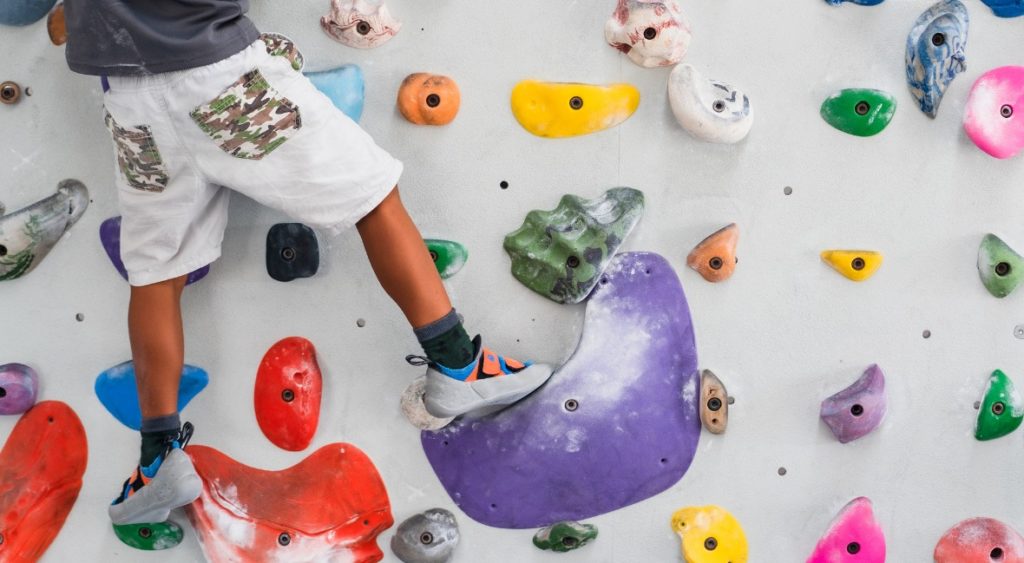
Climbing gyms will have rock climbing shoes that you can rent for your kids and generally have sizes as small as 12 or 13. When fitting climbing shoes, you want your child’s toe touching the end of the shoe, but you don’t want their toe curled up in the shoe. The sizes of climbing shoes don’t always match street shoe sizes, so it might take some trial and error to find a shoe that fits well.
Kids can wear climbing shoes with or without socks. Sometimes the shoe can rub the back of kids’ ankles, so it’s good to bring a taller pair of socks just in case.
If you want to buy shoes, check out our guide on climbing shoes for kids.
Harness
A harness is used as the attachment point for a rope. Kids can use a full-body harness that goes up over their shoulders or one that goes around their waist. A full-body harness is designed with a tie-in point at sternum level instead of hip level to make it virtually impossible for kids to flip upside down. Very young children should always be in a full-body harness as they don’t always have the core stability to keep themselves upright when lowering.
As kids get older and stronger there is no longer a need for a full-body harness. They’re also able to tighten the harness above their hips so that if they should flip upside down, they cannot slip out of the harness.
If you have learned to belay, you will know how to fit harnesses for your kids. Otherwise, the staff member you’re climbing with will check it for you.
You can rent a harness at the gym, or you can buy a harness after checking out this article by Outdoor Gear Lab on the best climbing harnesses for kids.
Chalk Bag
Chalk helps to absorb sweat and keeps hands from getting slippery while climbing. Kids get pretty excited about getting to use the chalk. To keep chalk dust to a minimum, kids should be instructed to squeeze the chalk ball inside the chalk bag instead of taking it out. Kids love to have their own chalk bag, but often you can rent one at the gym.
Comfy Clothes
Kids should wear clothes that are easy for them to move in. This includes shirts that are long and don’t ride up. Harnesses get pretty uncomfortable when they rub on bare skin. Avoid skirts if rope climbing with a harness.
Planning a Visit to the Climbing Gym
Now that you know all the rules and the two types of climbing, call your local climbing gym to find out all the options for bouldering and rope climbing. You may be able to explore the bouldering area on your own or hire a staff member to belay you and your kids on the ropes. Make sure to ask about prices and the available rental gear.
It will be essential to discover the youth policy of the gym for nonmembers. Some gyms allow parents and kids, while other gyms only allow kids if they’re enrolled in a class at the gym or if their family has a membership. At a minimum, all kids under the age of 14 will require your supervision to climb in the gym.
If this is your first visit, maybe begin by signing up for an hour with a staff member who can “show you the ropes.”
When to Visit the Climbing Gym
When navigating the climbing gym with kids, it is best to find a time when it isn’t too crowded. This will give you ample space to climb, and fewer people means less chance of walking or climbing underneath another climber.
Generally, weekday sevenings tend to be hectic, so the hours from about 5-9 pm should be avoided. If you have the flexibility to head to the gym on a weekday morning, you might find that you have the whole gym to yourself. Otherwise, early morning hours on weekends or after school from about 3-5 pm are good times as well.
FAQ About Rock Climbing For Kids
• What are the benefits of rock climbing for kids?
Climbing has many excellent benefits, and as teachers, we recommend it to parents often. Climbing is excellent for kids physically and mentally. It helps to strengthen their bodies and builds their gross motor skills. They improve their balance, coordination and gain an understanding of where their body is in space as they move up the wall and coordinate the movements between their eyes, arms, hands, legs, and feet. A strong core, hand, and arm muscles help support kids as they sit in chairs and write. This keeps them from getting fatigued at school and directly affects their academic success.
Next, climbing builds kids’ persistence, determination, and problem-solving skills as they try different ways to get to the top. They plan and execute movements, visualize solutions, and try again when faced with failure. It allows them to face risks in a controlled environment. Their resilience grows as they learn to cope with fear and stress. They know that they will be okay even if they slip or fall. Kids build their confidence and take pride in their success. Your kids will have a huge smile on their faces when they’re finally able to make a move that they’ve been working on.
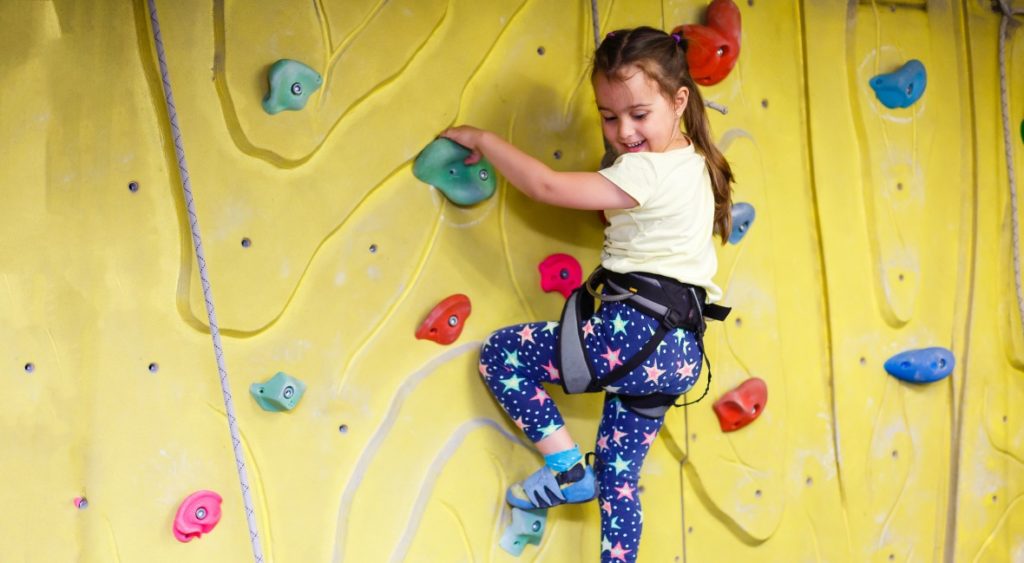
Finally, climbing helps kids to build a growth mindset. At times, there can be a lot more failures than successes. Kids will fall off again and again and again when trying to make a move or get to the top of the wall. They learn to value the process and celebrate their hard work.
And climbing is fun! That makes it a pretty stellar way for kids to be developing so many excellent skills. Some of their best learning can happen through play.
• How old do kids need to be to go rock climbing?
Kids can start climbing as soon as they can walk! We have seen 15 and 16-month-olds making their way up the wall at the gym. That being said, young kids are often only trying a few moves and would get just as much climbing done at the local playground. These kids usually have climber parents.

At about 3 to 4 years old, kids can start climbing. They enjoy the challenge of figuring out the moves and can climb down or follow the directions for being lowered down. Gyms will often have a kid’s area where they will create smaller routes with kids in mind. This might include shorter walls and holds that are closer together.
• Why don’t kids wear helmets when rock climbing in the gym?
Helmets are designed to protect people from rockfall when climbing outside; thus, there is no need for them inside. Also, when kids are rope climbing, the rope is kept tight, and they’re not taking any falls. When they do “fall”, it is more like sitting down and putting their weight on the rope. While bouldering, there are soft mats that provide hazard-free landing zones.
• What do all the numbers on the wall mean?
The numbers on each of the routes are the difficulty rating. They tell you how hard a particular route would be if you used only one color. Of course, kids (and adults) are welcome to use any holds they would like to get to the top of the wall.
Bouldering problems use the V scale. It starts at V0 and goes up from there. So a V4, for example, is going to be more challenging than a V3.
Rope climbs use the Yosemite decimal system. Climbs with be listed as 5.6, 5.7, 5.8, etc. Routes in the climbing gym will usually start around 5.6 and go up to 5.12 or 5.13.

Even when using holds from multiple routes,, it is good to climb where at least one of the climbs has a more accessible difficulty rating. This way, you know that some of the holds will be bigger and easier to use.
• My kid is afraid of heights. Can they still climb?
Yes! Bouldering can allow kids to stay close to the ground. They can remain low on the wall and try traversing from side to side. There are just as many fun moves this way.
Kids can also practice going up the wall just a little way while rope climbing. They will slowly learn to trust that the rope is holding them and that they are safe.
• Can I have my kid’s birthday party at the climbing gym?
Many gyms offer birthday party packages that include rental gear, use of a party room, and instructors. Call around to find the best options in your area.
Final Thoughts on Rock Climbing for Kids
Climbing might be just the thing if you’re looking to explore a new fun activity with your kids! Climbing provides lots of exciting challenges for all ability levels. There are always new moves to try as you and your kids build strength and technique.
Looking for other ways to get your family moving? Check out:


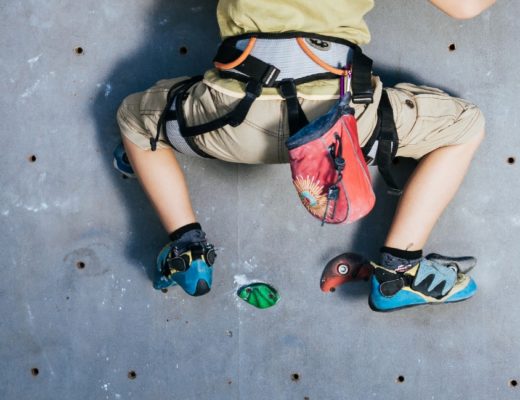
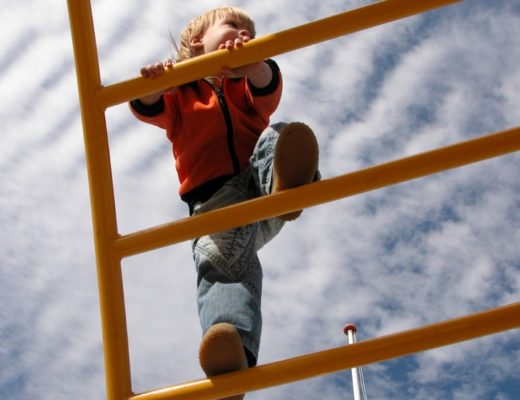
No Comments